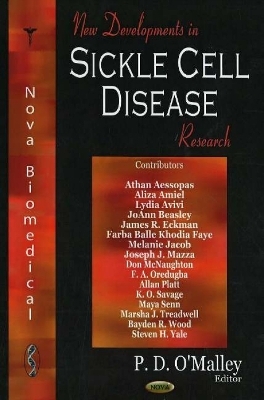
New Developments in Sickle Cell Disease Research
Seiten
2006
Nova Science Publishers Inc (Verlag)
978-1-59454-792-8 (ISBN)
Nova Science Publishers Inc (Verlag)
978-1-59454-792-8 (ISBN)
Sickle cell anaemia is an inherited blood disorder, characterised primarily by chronic anaemia and periodic episodes of pain. It is caused by an error in the gene that tells the body how to make haemoglobin. The defective gene tells the body to make the abnormal haemoglobin. This book gathers the research in this important field.
Sickle cell anaemia is an inherited blood disorder, characterised primarily by chronic anaemia and periodic episodes of pain and occurring in approximately 1 in every 400 African-American infants born in the United States each year. Individuals of Mediterranean, Arabian, Caribbean, South and Central American, and East Indian ancestry can also be affected. The underlying problem involves haemoglobin, a component of the red cells in the blood. The haemoglobin molecules in each red blood cell carry oxygen from the lungs to the body organs and tissues and bring back carbon dioxide to the lungs. In sickle cell anaemia, the haemoglobin is defective. After the haemoglobin molecules give up their oxygen, some of them may cluster together and form long, rod-like structures. These structures cause the red blood cells to become stiff and to assume a sickle shape. Unlike normal red cells, which are usually smooth and donut-shaped, the sickled red cells cannot squeeze through small blood vessels. Instead, they stack up and cause blockages that deprive the organs and tissue of oxygen-carrying blood. This process produces the periodic episodes of pain and ultimately can damage the tissues and vital organs and lead to other serious medical problems. Unlike normal red blood cells, which last about 120 days in the bloodstream, sickled red cells die after only about 10 to 20 days. Because they cannot be replaced fast enough, the blood is chronically short of red blood cells, a condition called anaemia. Sickle cell anaemia is caused by an error in the gene that tells the body how to make haemoglobin. The defective gene tells the body to make the abnormal haemoglobin that results in deformed red blood cells. This book gathers the latest research in this important field.
Sickle cell anaemia is an inherited blood disorder, characterised primarily by chronic anaemia and periodic episodes of pain and occurring in approximately 1 in every 400 African-American infants born in the United States each year. Individuals of Mediterranean, Arabian, Caribbean, South and Central American, and East Indian ancestry can also be affected. The underlying problem involves haemoglobin, a component of the red cells in the blood. The haemoglobin molecules in each red blood cell carry oxygen from the lungs to the body organs and tissues and bring back carbon dioxide to the lungs. In sickle cell anaemia, the haemoglobin is defective. After the haemoglobin molecules give up their oxygen, some of them may cluster together and form long, rod-like structures. These structures cause the red blood cells to become stiff and to assume a sickle shape. Unlike normal red cells, which are usually smooth and donut-shaped, the sickled red cells cannot squeeze through small blood vessels. Instead, they stack up and cause blockages that deprive the organs and tissue of oxygen-carrying blood. This process produces the periodic episodes of pain and ultimately can damage the tissues and vital organs and lead to other serious medical problems. Unlike normal red blood cells, which last about 120 days in the bloodstream, sickled red cells die after only about 10 to 20 days. Because they cannot be replaced fast enough, the blood is chronically short of red blood cells, a condition called anaemia. Sickle cell anaemia is caused by an error in the gene that tells the body how to make haemoglobin. The defective gene tells the body to make the abnormal haemoglobin that results in deformed red blood cells. This book gathers the latest research in this important field.
Preface; Malaria Resistance or Susceptibility in Red Cells Disorders; Resonant Raman Studies on Functional Erythrocytes; An Additional Copy of Chromosome 21 Drives Your Genes Wild; Psychobiological Reactivity in Children with Sickle Cell Disease: A Novel Variable for Prediction of Outcomes and Improving Interventions; Acute Chest Syndrome in Sickle Cell Disease: Pathophysiologic Approach to Management; A Decade of Advances in Sickle Cell Disease Management; The Heart in Sickle Cell Disease; Oral Health Status and Anthropometric Findings in Sickle Cell Disease; Index.
| Erscheint lt. Verlag | 2.8.2006 |
|---|---|
| Zusatzinfo | Illustrations |
| Verlagsort | New York |
| Sprache | englisch |
| Maße | 260 x 180 mm |
| Gewicht | 730 g |
| Themenwelt | Medizinische Fachgebiete ► Innere Medizin ► Hämatologie |
| ISBN-10 | 1-59454-792-0 / 1594547920 |
| ISBN-13 | 978-1-59454-792-8 / 9781594547928 |
| Zustand | Neuware |
| Haben Sie eine Frage zum Produkt? |
Mehr entdecken
aus dem Bereich
aus dem Bereich
Hämatologie und Internistische Onkologie
Buch | Softcover (2023)
ecomed-Storck GmbH (Verlag)
CHF 179,95
Buch | Softcover (2024)
Urban & Fischer in Elsevier (Verlag)
CHF 73,00


